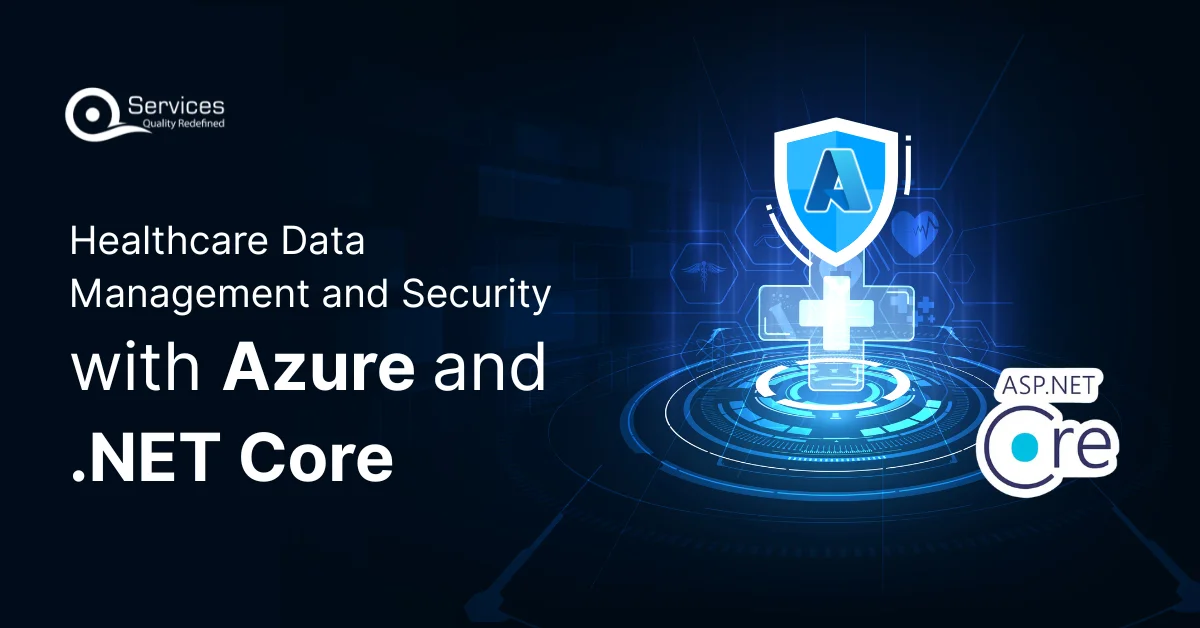
Home » Healthcare Data Management and Security with Azure and .NET Core

In the healthcare industry, managing and securing sensitive patient data is paramount. With the increasing adoption of cloud technologies, healthcare organizations are leveraging platforms like Microsoft Azure to store, process, and analyse healthcare data. However, with this shift comes the responsibility of ensuring data security and compliance with regulations such as HIPAA (Health Insurance Portability and Accountability Act).
In this blog, we will explore how to manage and secure healthcare data using Azure and .NET Core. We will cover various Azure services, best practices for data security, and provide a Proof of Concept (PoC) to demonstrate how to implement these concepts in a .NET Core application.
Azure Health Data Services is a suite of managed services designed to help healthcare organizations store, process, and analyze healthcare data securely. These services are built to comply with healthcare regulations such as HIPAA, GDPR, and more. Key services include:
Fast Healthcare Interoperability Resources (FHIR) is a standard for healthcare data exchange. Azure API for FHIR enables seamless integration and exchange of healthcare data.
A powerful analytics service that allows you to analyze large volumes of healthcare data.
Enables the development of machine learning models for predictive analytics in healthcare.
Provides advanced threat protection across all of your Azure services.
When dealing with healthcare data, it’s crucial to follow best practices to ensure data security and compliance:
Encrypt data both at rest and in transit to protect it from unauthorized access.
Implement RBAC to ensure that only authorized personnel have access to sensitive data.
Continuously monitor and audit access to healthcare data to detect and respond to potential security threats.
Anonymize data when possible to protect patient privacy.
Ensure that your data management practices comply with healthcare regulations such as HIPAA, GDPR, and others.
Get free Consultation and let us know your project idea to turn into an amazing digital product.

To get started with Azure Health Data Services, follow these steps:
If you don’t already have an Azure account, sign up at Azure Portal.
Navigate to the Azure Portal, search for “Azure API for FHIR,” and create a new instance.
Set up Azure Storage accounts to store healthcare data securely.
Enable Azure Security Center to get advanced threat protection and security recommendations.
Protected Health Information (PHI) is any information in a medical record that can be used to identify an individual. To secure PHI in a .NET Core application, follow these steps:
Ensure that your .NET Core application uses HTTPS to encrypt data in transit.
Use Azure Key Vault to manage encryption keys and encrypt sensitive data.
Use authentication and authorization mechanisms such as OAuth 2.0 and JWT (JSON Web Tokens) to secure API endpoints.
RBAC is a method of restricting access to sensitive data based on the roles of individual users within an organization. To implement RBAC in a .NET Core application:
Define roles such as “Admin,” “Doctor,” “Nurse,” and “Patient.”
Assign roles to users based on their responsibilities.
Use policy-based authorization in .NET Core to enforce role-based access.
Encryption is essential to protect healthcare data from unauthorized access. Azure provides several options for encrypting data:
Use Azure Storage Service Encryption (SSE) to encrypt data at rest. SSE automatically encrypts data before storing it and decrypts it when retrieved.
Use TLS (Transport Layer Security) to encrypt data in transit. Ensure that your .NET Core application uses HTTPS to enforce TLS.
Azure Monitor provides comprehensive monitoring and auditing capabilities for your healthcare data. To set up Azure Monitor:
Navigate to the Azure Portal and enable Azure Monitor for your Azure services.
Set up alerts to notify you of any suspicious activity or potential security threats.
Use Azure Monitor Logs to analyze and query logs for security insights.
Azure Security Center provides advanced threat protection for your Azure resources. To integrate Azure Security Center with your .NET Core application:
Navigate to the Azure Portal and enable Azure Security Center for your subscription.
Set up security policies to enforce best practices and compliance requirements.
Regularly review and implement security recommendations provided by Azure Security Center.
Azure Private Link enables you to securely access Azure services over a private network connection. To set up Azure Private Link:
Navigate to the Azure Portal and create a private endpoint for your Azure services.
Configure DNS: Configure DNS to resolve the private endpoint to a private IP address.
Restrict Public Access: Restrict public access to your Azure services and allow access only through the private endpoint.
In this section, we will build a simple .NET Core application that demonstrates how to securely manage and access healthcare data using Azure services.
Prerequisites
dotnet new webapi -n SecureHealthcareApp
cd SecureHealthcareApp
[ApiController]
[Route(“api/[controller]”)]
public class PatientController : ControllerBase
{
private readonly EncryptionService _encryptionService;
public PatientController(EncryptionService encryptionService)
{
_encryptionService = encryptionService;
}
[HttpGet(“{id}”)]
[Authorize(Policy = “DoctorOnly”)]
public IActionResult GetPatientData(int id)
{
// Simulate fetching PHI from a database
var phi = “Patient Name: John Doe, Condition: Hypertension”;
// Encrypt PHI
var encryptedPhi = _encryptionService.Encrypt(phi);
return Ok(new { EncryptedData = encryptedPhi });
}
[HttpPost]
[Authorize(Policy = “AdminOnly”)]
public IActionResult AddPatientData([FromBody] string encryptedData)
{
// Decrypt PHI
var decryptedData = _encryptionService.Decrypt(encryptedData);
// Simulate saving to a database
return Ok(new { Message = “Patient data added successfully”, Data = decryptedData });
}
}
Publish the .NET Core Application: Use Visual Studio to publish the application to Azure App Service.
Configure Azure API for FHIR: Set up Azure API for FHIR and configure it to securely store and retrieve healthcare data.
Enable Azure Security Center: Enable Azure Security Center to monitor and protect your application.
Authenticate: Use a tool like Postman to authenticate and obtain a JWT token.
Access Secure Endpoints: Use the JWT token to access secure endpoints and verify that role-based access control is enforced.
Share your project idea with us. Together, we’ll transform your vision into an exceptional digital product!

Managing and securing healthcare data is a critical responsibility for healthcare organizations. By leveraging Azure Health Data Services and .NET Core, you can build secure, compliant, and scalable healthcare applications. In this blog, we covered various Azure services, best practices for data security, and provided a Proof of Concept to demonstrate how to implement these concepts in a .NET Core application.
By following the steps outlined in this blog, you can ensure that your healthcare data is protected from unauthorized access and compliant with industry regulations. As healthcare continues to evolve, staying ahead of the curve with robust data management and security practices will be essential for success.
Shape
This blog provides a comprehensive guide to managing and securing healthcare data with Azure and .NET Core. By following the detailed steps and best practices outlined, you can build secure and compliant healthcare applications that protect sensitive patient data
Azure uses strong security tools like encryption (scrambling data so only authorized people can read it), identity management (making sure only the right people access data), and threat detection (finding and stopping security risks).
Azure is flexible, cost-effective, secure, and meets healthcare data regulations.
Yes, Azure has security certifications and tools to help healthcare companies comply with these laws.
What is .NET Core, and why is it used in healthcare?
.NET Core is a software development framework used to build healthcare apps like patient record systems and telemedicine platforms.
It allows developers to create fast, reliable, and secure apps for scheduling, virtual consultations, and managing patient information.
It includes built-in tools for authentication (verifying users), authorization (controlling access), and data protection.
Azure provides backup and disaster recovery solutions to restore lost data.
Cyberattacks like phishing (tricking people into giving sensitive data), ransomware (locking data until a ransom is paid), and insider threats (employees misusing access).
Use multi-factor authentication, conduct security checks, and train employees on security practices.
AI can analyze patient records, detect diseases early, and suggest personalized treatments.
IoT devices connect through Azure IoT Hub, and .NET Core processes real-time health data securely.

As digital expectations grow, customers now demand speed, ease of use, and 24/7 availability. To meet these demands at scale, digital-only banks choose business process automation in the banking industry to deliver consistent, responsive, and personalized service.

Processing payments involves multiple steps, such as verifying account details, checking records, and ensuring timely execution. In the current financial environment, manual approaches slow down these processes and increase the risk of errors.

Robotic Process Automation (RPA) is no longer limited to large, national banks. Smaller financial institutions like community banks, credit unions, and regional institutions have started implementing this modern automation to find real, practical value.
INDIA : F-190, Phase 8B, Industrial Area, Sector 74,
Mohali, India
CANADA : 55 Village Center Place, Suite 307 Bldg 4287, Mississauga ON L4Z 1V9, Canada
USA :2598 E Sunrise Blvd, Fort Lauderdale,FL 33304,
United States

Founder and CEO

Chief Sales Officer
